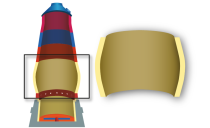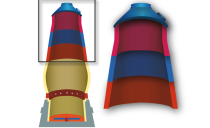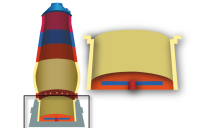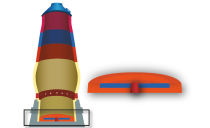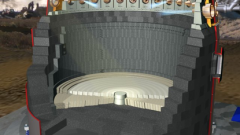
High Performance Materials in Blast Furnaces
A blast furnace hearth is subject to severe chemical attack and thermodynamic strain in every single processing run throughout its service life. This is where coke, iron ore, and limestone are melted by pressurized combustion air at temperatures exceeding 1,000 °C. The molten iron is then tapped and separated into slag and pig iron; a process that is increasingly continuous thanks to modern production capabilities and the availability of high performance materials.
Challenging conditions affect every are of a conventional blast furnace. For hearth pad and hearth wall, tuyere belt, bosh and belly, lower and upper stack, the lining of these areas have to deal with the likes of molten iron, corrosive vapors, and abrasion from the solid burden. Raw materials entering through the throat may be a source of wear and tear, while coarse particles and carbon monoxide-rich gases produced as by-products can cause problems from the bottom-up.
There are countless methods of failure threatening blast furnace components, which could cause process inefficiencies or mandatory downtime for costly maintenance and repair. High performance materials are subsequently imperative throughout modern blast furnace designs.
Upper Stack & Lower Stack: Hard-Wearing Efficiency
High-temperature performance is not the most critical parameter in the upper stack of a conventional blast furnace. This is the uppermost section, beneath the throat, hopper or bell where raw materials are fed into the system. As a result, abrasion by incoming solid burden is one of the greatest concerns from a design and performance perspective.
Dense ceramics like silicon nitride-bonded SiC refractories are ideal for refractory linings of this nature. Our Refrax 20 SBF is one of the standout materials for upper stack furnace linings due to its unparalleled abrasion-resistant properties and dimensional stability. It also excels in lower areas of the stack where concerns of solid burden wearing give way to the threat of temperature-driven attack by aggressive vapors.
The belly of a blast furnace is a cylindrical section that connects the lower stack to the upper bosh, which is the hottest part of a blast furnace. This is because the bosh is located above the tuyere belt where pressurized combustion air is injected into the system, so it is in constant proximity to coke-air reactions. The presence of alkalis and zinc is combined with the common occurrence of nascent molten iron and slag, making the bosh and belly one of the most challenging sections of the blast furnace.
Sialon-bonded silicon carbide products like Sicanit AL3 are approved for use in bosh and belly configurations, although the right high performance material is usually determined on a process-specific basis. When a low conductivity lining is preferred the sialon bonded corundum grade of Coranit 3S is a great choice. Coranit 3S is also the best choice when high amounts of hydrogen (H2) are injected into the tuyeres.
Hearth Linings: Innovative Solutions
At Saint Gobain High Performance Ceramics and Refractories, we have pioneered and promoted an innovative solution to the challenges put forward at the start of this article. Our novel Ceramic Cup technology has been setting performance benchmarks in high throughput blast furnaces since 1982. Based on a unique SiAlON-bonded Corundum product known as Coranit SlagR, our novel solution for blast furnace hearth wall linings offers extended service in the most challenging conditions.
If you would like to learn more about our high performance materials for blast furnace applications, simply contact a member of the Saint-Gobain team today.
Related Content
Belly and Bosh Products
Discover Saint-Gobain Performance Ceramics & Refractories’ range of silicon carbide or corundum-based bricks – ideal belly and bosh solutions.
Upper and Lower Stack Products
Discover Saint-Gobain Performance Ceramics & Refractories’ range of brick and shotcrete solutions for the upper and lower stack.
Hearth Products
Discover Saint-Gobain Performance Ceramics & Refractories' Coranit Ceramic Cup - widely recognized as the ideal solution for extended hearth service life.
Ceramic Pad Products
Discover Saint-Gobain Performance Ceramics & Refractories’ range of pad bricks – available in circular or herringbone designs.
Blast Furnaces Refractories
Descubra a gama de soluções refractárias da Saint-Gobain Performance Ceramics & Refractories para aumentar a vida útil dos altos-fornos.
